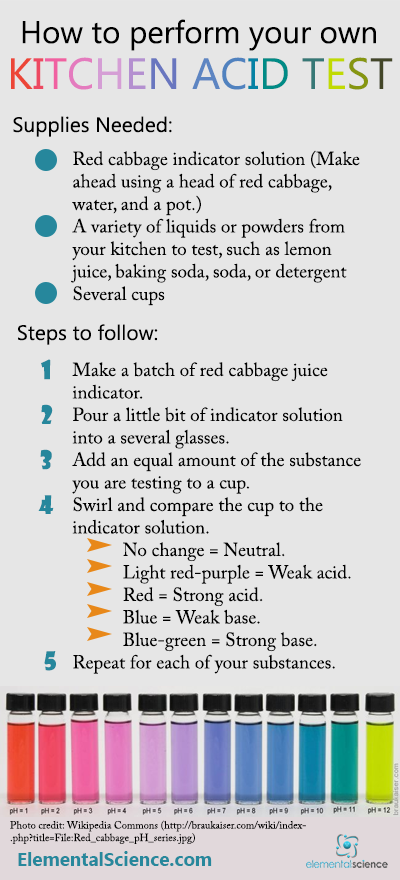FREE Shipping on all our products! (Please Note: Orders may experience a delay of a week or more in shipping due to the high volume of orders at this time of year.)
FREE Shipping on all our products! (Please Note: Orders may experience a delay of a week or more in shipping due to the high volume of orders at this time of year.)
How to perform your own Kitchen Acid Test
January 08, 2018 3 min read
A kitchen acid test is always fun because of the color changes. But more than that, this hands-on science activity is a great way to show your kids a bit about the chemistry of acids and bases!
How to perform your own Kitchen Acid Test

How to make the indicator solution
For this experiment, you will need to make your own indicator. To do this you will need:
- A head of red cabbage
- Water
- Pot
Here is how to make your own red cabbage indicator solution:
- Make your indicator solution.
- (Adults need to do this step.) Chop up your head of cabbage and boil it in water for 15 minutes.
- Drain your cabbage through a sieve, taking care to save the water in a container. (Use caution when doing this step as the water will be very hot!)
- Set the water aside and let cool for several hours.
Once the red cabbage indicator solution cools, it is ready to use.
The Kitchen Acid Test
Now, you are ready to do you kitchen acid test. The first step is to gather a few supplies.
What you need
You will need:
- Red cabbage indicator solution
- A variety of liquids or powders from your kitchen to test, such as lemon juice, baking soda, soda, or detergent
- Several cups
Safety Note: Although there are many safe acids and bases in your kitchen, as a general rule you should avoid touching acids or bases without the proper protection!
What to do for your kitchen acid test
Here are the steps to follow for your kitchen acid test:
- Pour a little bit of indicator solution into several glasses and set one glass aside to use as your control.
- Add an equal amount of the substance you are testing to a cup. (Use caution when doing this step as some substances like bleach can damage clothing.)
- Swirl the cup and compare it to the control cup to see if there are any changes. Compare the changes to determine whether the substance is an acid or a base. (If your solution did not change color, the substance is neutral. If your solution turned a light red-purple, the substance was a weak acid. If your solution was red, the substance was a strong acid. If your solution turned blue, the substance was a weak base. If your solution was blue-green, the substance was a strong base.)
- Repeat for each of your substances.
What should happen
Here is a look at what happened in your kitchen acid test:
A typical kitchen is full of weak acids, such as vinegar, and weak bases, such as baking soda. Acids normally taste sour and can be corrosive if they are strong enough. The same is true for bases, except they feel slippery.
Acids and bases can be very harmful, so we never use a taste or touch test to determine an acid or a base. Instead, we use an indicator solution. In the kitchen, red cabbage can be used as an indicator, meaning that it changed color in the presence of an acid or a base. And that is exactly what we did in this kitchen acid test.
You can also use cranberry or blueberry juice as an indicator, but the change is not as colorful as the one you get with red cabbage juice!
A few more chemistry ideas
Chemistry can be fun, especially if it’s introduced early in life through experimentation. Here are a few more articles to help you with chemistry in your homeschool:
Also in Homeschool Science Activities
Don’t Be Afraid To Try These 3 Christmas Tree Experiments Right Now
December 07, 2024 3 min read

It's the most wonderful time of the year and these three Christmas tree experiments will make your season even brighter! Click "Read More" to see them.
Steps For Dissecting A Seed By Felipe Moreno
November 09, 2024 2 min read

Felipe Moreno, one of the Sassafras twins' botany experts, shares an Argentinian folk ballad which shares the steps for dissecting a seed.
How to make a Beautiful Fall Leaf Book {A Fall Science Activity}
September 21, 2024 2 min read

Want to preserve the beauty of fall for science? Click "Read More" to learn how to make a fall leaf book and download the free templates!
Subscribe
Sign up to get the latest on sales, new releases and more …

